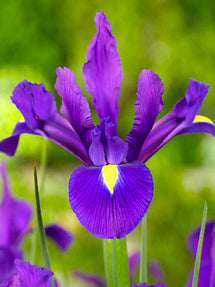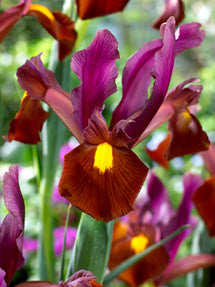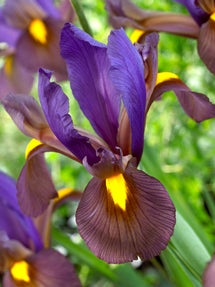Iris
Bring Colour And Elegance To Your Spring Garden With Iris Flowers
Introduce striking colour and elegance to your garden with exquisite Iris blooms. These graceful flowers come in a wide variety of shapes and an impressive spectrum of hues. Alongside classic shades of blue, violet, purple, yellow, and white, you’ll also find more unusual tones, such as bronze, orange, and even pink. Irises offer a wonderful combination of structure, texture and charm, enhancing any outdoor space. They’re easy to grow, reliable, and cherished by gardeners of all experience levels.
At DutchGrown, you will find a carefully curated selection of Dutch Iris and Dwarf Iris bulbs, ideal for creating a garden that’s not only beautiful but uniquely yours. Begin planning your magnificent garden in the UK today.
Showing 1 - 3 in 3 items
From Bearded To Siberian: Irises Cherished Through The Centuries
The Iris genus, part of the Iridaceae family, encompasses hundreds of varieties, including Dutch Iris, Japanese Iris, Dwarf Iris, Bearded Iris and Siberian Iris. The name ‘Iris’ derives from the Greek word for ‘rainbow’. As one of the earliest cultivated garden flowers, Irises have adorned gardens for over 2,000 years. With such a rich history, these graceful blooms have featured in the gardens of Pharaohs, medieval monasteries and royal estates alike. Their enduring appeal lies in their refined beauty, upright flowers paired with sword-like foliage, which suits formal beds, cottage gardens and naturalised settings equally well. Their vivid colours also make them a firm favourite for cutting gardens and as cut flowers in floral arrangements.
Despite their refined appearance, Iris bulbs are remarkably easy to grow. They flourish in most well-drained garden soils and adapt readily to a range of climates. Even novice gardeners can achieve success with Irises, as these low-maintenance perennials return year after year with minimal effort. Many varieties will also multiply naturally over time, steadily increasing their display each season. For a vibrant and varied spring show, consider planting iris bulbs alongside other favourites such as Tulips, Daffodils and Hyacinths.
Dutch Iris Vs Dwarf Iris: Two Distinct Species Worth Growing
At DutchGrown, you'll find a thoughtfully curated selection of Iris species, with two standout types deserving special mention: the Dutch Iris and the Dwarf Iris. Both deliver exceptional beauty and reliable performance, yet each brings its unique charm to the garden.
Dutch Iris (Iris Hollandica): A Late Spring Delight
The Dutch Iris (Iris “Hollandica”) is prized for its tall, straight stems and orchid-like blooms with silky petals. Flowering in late spring, it’s ideal for bridging the gap between spring and early summer. Dutch Irises offer a striking array of colours, often adorned with exotic markings. Their blooms are also highly valued for their excellent vase life, making them a favourite for floral arrangements. Fun fact: despite their name, Dutch Irises have never grown wild in the Netherlands. They are the result of expert hybridisation by Dutch growers.
Dwarf Iris (Iris Reticulata): A Petite Size Of Flowering Plant
The Dwarf Iris (Iris “Reticulata”), also known as the “Reticulated Iris”, is one of the first flowers to emerge in early spring, often blooming while traces of winter still linger. Its delicate petals are most commonly found in shades of blue and purple, though some cultivars produce white flowers. This compact, low-growing plant is a perfect choice for front borders, beneath deciduous trees, in rockeries, or in pots, offering a splash of vibrant colour to early-season landscapes. Its ability to thrive in small spaces makes it a firm favourite among gardeners with limited room or in cooler spring climates. Fun fact: Iris “Danfordiae” is the only Dwarf Iris variety with bright yellow blooms.
How To Grow Iris Plants For Maximum Impact In Your Garden
Their orchid-like blooms may appear exotic, but Iris bulbs are remarkably easy to grow. To achieve the best results in your outdoor space, it’s important to plant them correctly from the start. Here’s how:
Plant your Iris bulbs between early and late autumn, once the soil temperature has dropped to 15°C or lower. This usually occurs between September and November, depending on your local climate. Select a sunny spot or a location that receives partial shade, with well-drained soil, as Iris bulbs do not perform well in damp conditions. Space the bulbs approximately 7–8 cm apart and plant them at a depth of 10–13 cm below the soil surface, with the pointed end facing upwards. If you're planting in containers, you may position the bulbs slightly closer together, but ensure they do not touch one another. After planting, water thoroughly just once, then only water moderately throughout the growing season to avoid waterlogging. Do you live in a colder climate? Move the containers to a sheltered area, such as a cool greenhouse or cold frame, to overwinter.
After the flowering time, allow the foliage to die back naturally. Wait until the leaves have turned completely yellow and withered before removing them. Need more specific guidance? Follow the instructions in our growing guide ‘How to Grow Iris’.
Dwarf Iris And Dutch Iris Bulbs For Sale At DutchGrown
Would you like to grow Dwarf or Dutch Iris in your garden? Whether you're planting a handful of bulbs in your home garden or designing a more expansive landscape, both varieties offer outstanding performance. At DutchGrown, we provide only top-quality Dwarf and Dutch Iris bulbs (bulb size between 6 and 8 cm), carefully selected for their vigour and dependable blooms. Our curated collection features timeless favourites alongside distinctive varieties, making it easy to find the perfect fit for your garden. Browse our Iris bulbs collection today and begin planning a vibrant spring display. We offer delivery throughout the UK.
Frequently Asked Questions About Iris Bulbs
What Is An Iris Bulb?
An Iris bulb is an underground storage organ that produces the elegant, colourful Iris flower. It contains all the energy the plant needs to sprout, bloom, and return year after year. While some varieties grow from rhizomes, others grow from bulbs. There are several species of Iris, including Dutch Iris, Japanese Iris, Dwarf Iris, Bearded Iris, and Siberian Iris.
What Should I Do With Iris Bulbs?
Irises are spring-flowering bulbs that should be planted in the autumn. The exact timing will depend on your local climate. In cooler regions, plant them in September or October, once the soil temperature has dropped to around 15°C. In warmer areas, the ideal time is from October to November. Ensure you plant the bulbs in a location with full sun or partial shade.
Do Iris Bulbs Need To Be Dug Up Every Year?
Iris bulbs do not need to be lifted every year, as they are perennial plants that will often multiply when grown in suitable conditions. They are cold-hardy and can thrive in cooler climates. However, if your Irises stop producing blooms, they may have become overcrowded. In this case, lift the bulbs in early autumn, separate them, and replant to encourage healthy growth.
Will Iris Bulbs Multiply?
Iris bulbs will multiply under the right growing conditions. Over time, they form clumps that increase in size with each passing season. To keep them healthy and ensure they continue to flower reliably, it is advisable to divide and replant them every 3 to 5 years. This helps prevent overcrowding and allows each bulb to produce strong, showy blooms year after year.


